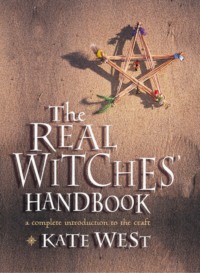Kitap dosya olarak indirilemez ancak uygulamamız üzerinden veya online olarak web sitemizden okunabilir.
Kitabı oku: «The Real Witches’ Handbook»
THE
REAL WITCHES’
HANDBOOK
A Complete Introduction to the Craft for Both Young and Old
KATE WEST

Copyright
Element
An Imprint of HarperCollinsPublishers 1 London Bridge Street London SE1 9GF

and Element are trademarks of HarperCollinsPublishers Ltd
First published by Thorsons, an Imprint of HarperCollinsPublishers 2001 This edition published by Element 2003
17 16
© Kate West 2001
Kate West asserts the moral right to be identified as the author of this work
A catalogue record for this book is available from the British Library
ISBN 9780007105151
Illustrations by Chris Down
All rights reserved under International and Pan-American Copyright Conventions. By payment of the required fees, you have been granted the non-exclusive, nontransferable right to access and read the text of this e-book on-screen. No part of this text may be reproduced, transmitted, down-loaded, decompiled, reverse engineered, or stored in or introduced into any information storage and retrieval system, in any form or by any means, whether electronic or mechanical, now known or hereinafter invented, without the express written permission of HarperCollins e-books.
Ebook Edition © FEBRUARY 2012 ISBN: 9780007483389
Version: 2019-10-09
CONTENTS
Cover
Title Page
Copyright
INTRODUCTION
WITCHCRAFT: THE MYTHS
WITCHCRAFT IN REALITY
MOON WORSHIP?
THE EIGHT SABBATS
BECOMING A WITCH
MAGIC
SPELLCRAFT AND HERB LORE
OUT OF THE BROOM CLOSET
GETTING IN TOUCH
TERMS AND DEFINITIONS
FURTHER READING
ACKNOWLEDGEMENTS
About the Author
About the Publisher
INTRODUCTION
Welcome to The Real Witches’ Handbook. This book is written for all those who are young to the Craft of the Witch, whether in years or in experience. Within these pages you can discover how Witchcraft can be practised by anyone who wishes to, even in this, our modern, crowded world. Welcome to a new way of thinking where you can take charge of your life and your destiny.
Today there is a new growth in spirituality and Witchcraft is one of the fastest-growing religions in the world. People are turning away from the better known patriarchal belief systems, with their rules and regulations. They are turning away from religions where they need an intermediary or priest to intercede and interpret their Gods for them. They are tired of being told what to believe, how to worship and what decisions they should make in their personal lives. They want to take charge of their lives, their morality and their beliefs. Having seen the mess that authority of one sort or another has made, people are no longer content to take on trust the information which is passed down to them. They want to talk to their God and/or Goddess directly, and to worship in a way which seems natural and right to them.
Thanks largely to the World Wide Web and the Internet there is an increasing amount of information available on religions both old and new and an increasing openness about Witchcraft, which was previously a very reticent religion. As a result more and more people, of all ages and occupations and of both sexes, are becoming interested in Witchcraft, or ‘the Craft’, as it is also known. This interest is also being encouraged by fictional portrayals in books, films and TV. However, these come complete with many misconceptions and elaborations and it can be difficult for those new to the Craft to determine what is accurate and what is myth, especially if they have no one to guide them.
For the young it is especially hard as Witches have traditionally held that reputable Covens (the name for a group of Witches) do not accept members who are under 18 years old. This is partly because it is felt that the individual should have the opportunity to make an informed decision about their choice of spirituality (and therefore needs time to assess the options), partly because they should also have some life experience and maturity (although 18 is quite an arbitrary age to choose for this) and partly because taking on candidates under that age would (in most parts of the world) leave the group open to all kinds of accusations of corrupting minors.
This combination of increased interest and information leads to the modern Witch’s dilemma: how to treat those who are under the age of 18? A few reputable groups have always had a policy of encouraging exceptional candidates, usually by a process of one-to-one support given by a senior member of the Coven, until such time as the ‘age limit’ has been passed. This support sometimes takes the form of supplying a formidable reading list and counselling patience, something which simply tends to alienate all but the most dedicated seeker. This is especially true as most of the better books were written a long time ago and were intended to be read by those who already had access to a group setting. In this day and age we have to recognize that from the age of 14, people are making decisions which could affect the rest of their lives, in exam choices for example, and at 16 they may set up home and/or marry.
